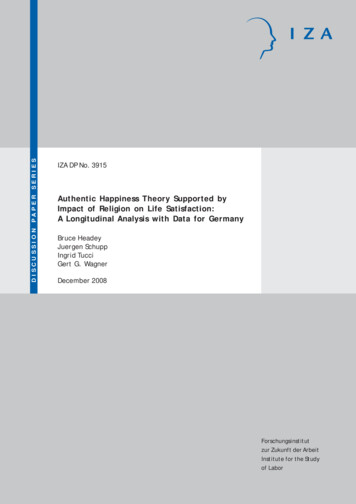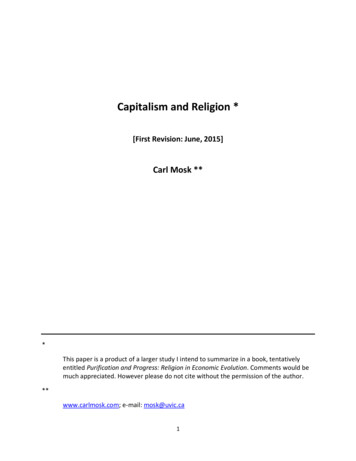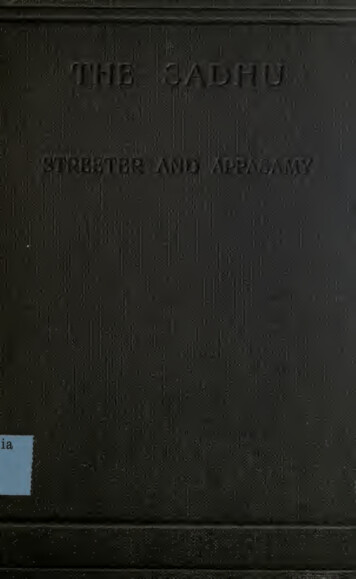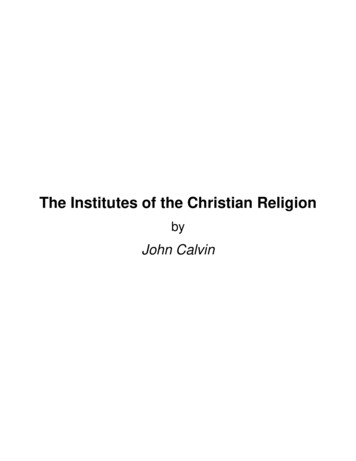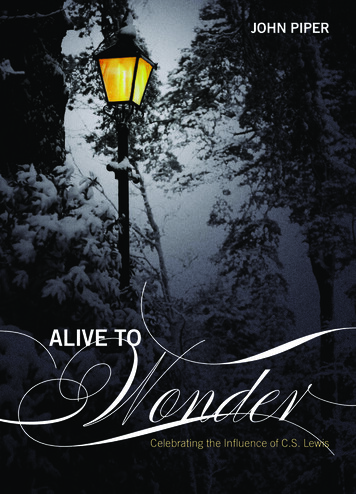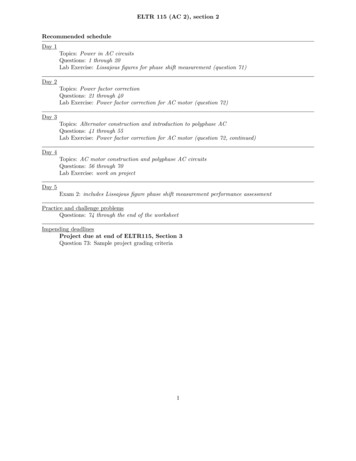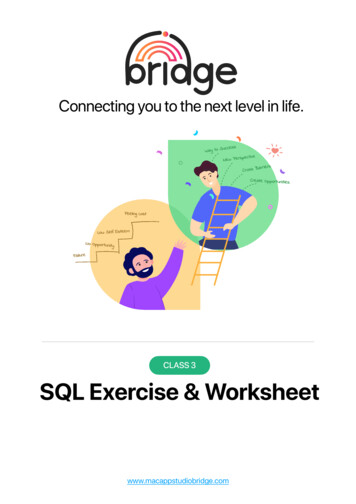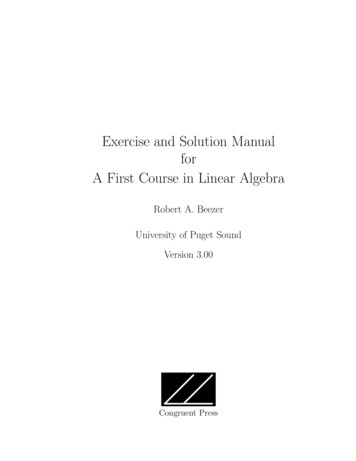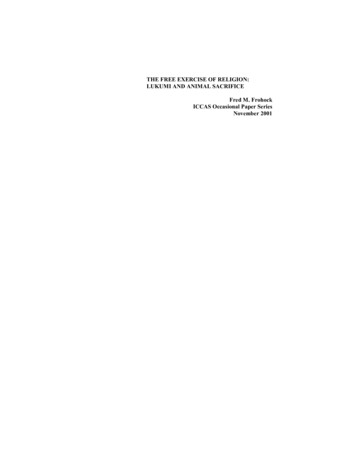
Transcription
THE FREE EXERCISE OF RELIGION:LUKUMI AND ANIMAL SACRIFICEFred M. FrohockICCAS Occasional Paper SeriesNovember 2001
2The Free Exercise of Religion:Lukumí and Animal SacrificeEarly LifeErnesto Pichardo was born in Havana to a middle-class family. His mother hadbeen introduced to Osha (a religion known also as Lukumí or Santería) as a child througha first generation olorisha (priest) who was the family cook. The father's side ofErnesto’s family, socially prominent with an economic history that included ownership ofsome sugar plantations, was active in both Catholic and Espiritismo groups. Pichardorecalls no conflict in these religious activities, except that the Espiritismo activities werekept private for social reasons. The gradual shift in the family to a complete reliance onOsha began for health reasons. His mother had toxicity problems during her secondpregnancy that caused a miscarriage. The doctors could not control toxic reactions thenand so they warned her that a third pregnancy would kill her.The olorisha had moved out of the Pichardo home by the time of this warning andwas marketing his skills to a number of families. He had also become a priest of Shangó,an Osha divinity believed to have been the fourth king of Yoruba, and commandedconsiderable respect on medical issues and problems. The young Pichardo woman whowas to become Ernesto’s mother began visiting this priest and complying with the ritualshe recommended. He became an authoritative force in her religious life. He predictedwell in advance of Ernesto's birth that she was going to have another child, a male child,and that in spite of what the doctors had said nobody was going to die and in facteverything was going to go well. He also predicted this child would become a priest inOsha and described a number of events and accomplishments that would occur in thechild's life.
3Ernesto was born without any complications and was raised in one of the affluentbarrios in Havana. The family moved to the United States in the early 1960s and settledin the "Little Havana" area of Miami, a zone on and near Calle Ocho (S.W. 8th Street).They were extremely poor at first. Their home was a garage that they slowly converted toan efficiency apartment. By this time Ernesto's parents had divorced and his mother hadremarried. His stepfather was a professional with five college degrees who could not findwork because of his green card status. He would get up at 4:00 a.m. every day and startwalking, looking for any kind of work. Finally he landed a job parking cars in the EdenRoc Hotel in Miami Beach. His mother went through a scary time in the hospital afteraccidentally poisoning herself while fumigating rats in their garage apartment. But sheeventually recovered her health and found employment at one of the local garmentmanufacturers. Ernesto and his older brother Fernando were basically on their ownduring the day. They would get up in the morning, scratch up something for breakfast,and then leave for school. Resources were exceedingly scarce. The governmentassistance program for Cuban refugees would not be passed for years.The economic status of the Pichardo family soon improved, however. In the late1960s they located a relative in New York who had arrived earlier and been somewhatsuccessful economically. The Pichardos convinced him to invest as a partner in agarment factory to be managed by Mrs. Pichardo. The factory did very well, at one pointoperating two shifts, one at night and the other during the day. The Pichardos becamecaught up in the American dream of economic independence and comfort. They boughttheir first automobile. They purchased a comfortable house in Hialeah, a municipalityadjoining Miami. Ernesto and his big brother went to public schools in the city of
4Hialeah. He became an altar boy in the Catholic Church during his years in elementaryschool.At about that time Ernesto began to feel that it was time to "pay up" on what theYoruba priest had outlined as his destiny. The Osha religion was growing very rapidly inMiami during these years, in part because of the increased immigration from Cuba butalso because of the intrinsic practical appeal of the religion to the Cuban-Americancommunity. Ernesto explored its beliefs and rituals and felt that his tendencies, hisinstincts, were more inclined toward Osha than Catholicism. His mother was initiatedinto the religion in 1970. Ernesto's conversion to Osha followed three days later. Hisordination was into the priesthood order of Shangó. Three years later his brother andgrandmother became Osha priests, and then his grandfather followed him and his motherinto the religion in recognition of what they had been told by the Yoruba priest in Cubamany years before.The ordination destroyed Ernesto's chances for a degree from Hialeah high school.He was sixteen years old and in the middle of his junior year. He had to be out of schoolduring the 7-day confinement period of the ordination ceremony, and for certain eventsduring the first months after that week. The school required a doctor's letter attesting toan illness in order for a student absent for that length of time to be reinstated. Ernesto hadno such letter. Moreover, he reported back to school after the confinement period withthe signs of an Osha initiation still prominent on his person: his hair was completelyshaved off, he was dressed entirely in white, and religious paraphernalia adorned hisbody. The principal went berserk on seeing him. He expelled Ernesto from school andeven threatened to have him arrested if he was seen on the streets.
5Pichardo recalls the experience as a complete transformation in his life. He hadbeen very popular in the neighborhood and school. Suddenly he was this weird thing tobe avoided at all costs. From best friends all the way down the line to socialacquaintances, except for his girlfriend, he was shut out entirely. The displacementincluded both the everyday routine of school attendance and his social life. This abruptisolation from friends and schoolmates was devastating. At the same time he had theextended family of a new religion. Suddenly he had new grandfathers, grandmothers,aunts, uncles, all absorbing him into the religion. His life changed from that of a typicalAmerican teenager to an ordained priest completely immersed in the social framework ofOsha.Pichardo's first priority was finding a job. It was difficult. He was young and hestill looked bizarre from the perspective of secular employers. He convinced his elders inOsha to give him an exemption from religious attire for work purposes. He could goabout with his head uncovered (and by this time his hair had grown in a bit, though it wasstill very short) and wear pastel colors instead of white. But this exemption applied onlyto work hours. As soon as he returned from his job he had to change back into religiousattire. This dress code was in effect until the completion of the ordination (one year). Hemanaged to get a job in a retail shoe store during the Christmas rush. They kept him onpast the holiday season. He later became a manager in the shoe company and then adistrict trouble shooter for the whole Florida region. During this time he enrolled in anadult education program at the University of Miami and in two years had earned his highschool degree. He also opened a botánica (an Osha shop for the sale of religious items)and operated that as well. In 1977 he left the shoe business and became a bill collector.The pay was much better but he found the work just as stressful. His life by then had
6become completely defined by his job and his business, and the Osha religion thatdominated his leisure time.Eventually Pichardo was accepted for training in the higher priesthood of Osha. In1977 he completed a period of study and was acknowledged as an italero in the religion,though he says that the study regimen never ends. He likens his efforts to going tocollege forever. His curriculum included extensive work in cultural anthropology, whichhe believes he used (without knowing at the time what it was called) in his investigativework as a bill collector. In the courses he took at local colleges he began engagingscholars who had extensive knowledge of Nigeria and Osha traditions. He became a kindof apprentice to some of those scholars, helping them with insights into the practicingworld of Osha while learning the historical and anthropological bases of the religion.Soon Pichardo began organizing workshops with a foundation grant that broughtacademics and priests (both Catholic and Osha) together to discuss issues in the Oshamovement. Public forums were held that included university professors, olorishas, andrepresentatives of the Catholic Church. Pichardo continued to expand his economicinterests in corporate America, accepting positions on the executive boards of a numberof area businesses.Original Models and SyncretismRegla de Osha, in some ways a syncretic religion, originated in an odd and painfulhistorical accommodation between Yoruba and Catholicism in the slave culture of Cuba.Yoruba is a culture that can be traced back at least 5,000 years in Africa. The Yorubapeople lived in what is now the southwestern part of Nigeria and eastern Benin. It wasone of the regions in Africa from which blacks were enslaved and transported to Spanish
7colonies in the New World during the 16th, 17th, and (primarily) the late 18th and 19thcenturies. The Africans taken to Cuba were sent to the sugar and tobacco plantations.The conditions of life there were as bad as one might expect in the practice of slavery. Inthis coercive and hostile setting the Africans encountered the Catholic Church and itsmessage of eternal salvation through Christ and the sacraments. All of the slaves wereroutinely "converted" to Catholicism through mandatory baptism upon arrival in thecolony. The result was a tense and radically incomplete surface fusion of Yoruba andCatholicism.The encounter story, whatever its form, must be seen as coercive in all respects.The slaves arriving in Cuba had no knowledge of Christianity. The baptisms wereadministered to recipients who did not understand any part of the ceremony. Some priestsdid visit the plantations later to give informal instructions in Catholicism. But theobvious asymmetry in power between instructor and student invested these lessons withcompulsion. Even those slaves who were freed entered a society dominated byCatholicism, and understandings of Catholic practices and symbolism were crucial tosurvival. This frame of reference helps explain why the coercive introduction ofCatholicism to Yoruba culture never produced the contradictions of principle one mighthave expected in the forced joining of two discourses or practices. Slaves have alwaysfound it useful (in the deep sense of survival) to align in some way with the institutions, ifnot the beliefs, of their owners, and the incentive among slaves in Cuba for a pragmaticacceptance of Catholicism was predictably strong. Lydia Cabrera, a folklorist who didimportant early field work on Osha culture, saw the new religion as an instrumentfashioned by slaves to avoid retaliation for pursuing heathen practices. Leavening thissurvival strategy was the fact that the two religions had much in common -- beliefs in a
8single overriding God, an external reality, interventionist spirits, the sacredness of nature,blessed objects, miracles and the power of prayer, the importance of ritual, and thepossibility of spiritual healing and divine protection from harm.But the absence of strong contradictions may also be explained by the fact that nocomplete fusion or even an equitable balance of Yoruba and Catholicism has everemerged from the acceptance. The incentives in Yoruba to maintain the beliefs andpractices of the homeland during the diaspora must have been compelling. A collectivememory of Africa, which most of the slaves never saw again, was embedded in theYoruba religion. We know that the If a priests memorized and retained the Odu Corpus,the core content of Yoruba, and kept it secret from the slave owners. (One word for priestin Yoruba is babalawo, which also can be translated as Father of Secrets). Any fusionbetween the two religions was accordingly layered in crucial ways along the dimensionsof surface accord and underground convictions. The result is an alignment that is littlemore than a surface wrapping of parallel structures from distinct cultures, or at best a reexpression of Yoruba with a Catholic veneer. Some members of Osha, and severalscholars of the religion, maintain that the syncretism assigned to Yoruba is found only inthe pragmatic responses of members to a dominant culture, not in the religion itself.Also, the coercive origins of Osha led to a hostility between the two religious groups, andcultures, that has kept the religious structures independent to some degree, a hostilitywhich exists in various forms even today.There is a case, and an impressive argument, for syncretism in Osha. In the workdeveloped by Mercedes Sandoval, for example, we must understand Osha, and allreligions, as a chamber, a generous and open vault containing many cultures. Sandovalreminds us that the Hispanic culture during the slave trade was itself heterogeneous,
9consisting of a patchwork quilt of contributions by the Jews, Muslims and Catholicsresiding in Spain, as well as markings from the cultural regions of Catalonia, the Basquecountry, Galicia and other areas. The Catholicism taken to Cuba was definitely pluralisticand distinctly Mediterranean, and included the worship of saints and a fascination withmystical languages. Cuba itself was dense with beliefs in miracle healings andsupernatural events in general, and was influenced by an Espiritismo movement thattraded in magic and even witchcraft. The country presented a culture of ambiguityreinforced by the multiple and conflicting subcultures that stretched across the isla
The Free Exercise of Religion: Lukumí and Animal Sacrifice Early Life Ernesto Pichardo was born in Havana to a middle-class family. His mother had been introduced to Osha (a religion known also as Lukumí or Santería) as a child through a first generation olorisha (priest) who was the family cook. The father's side of Ernesto’s family, socially prominent with an economic history that .
